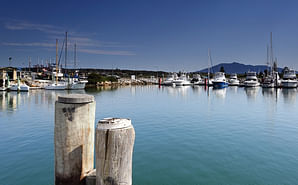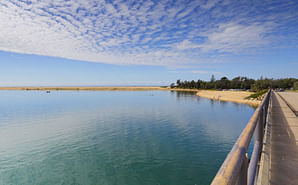Merimbula STP
Some frequently asked questions and answers.

Questions and Answers
- The upgrade will improve the quality of treated wastewater and minimise public health and environmental risks with using and disposing treated wastewater.
A: With two treatment plants (Tathra and Bemboka) already utilising solar power, we are well on our way to bringing solar to all our most power-hungry water and sewerage assets, including the Merimbula Sewage Treatment Plant.
This combined $3 million investment over the next three years will, in the case of the Merimbula STP, offset 25% of the treatment plant’s annual power use and costs.
As our most power-hungry sewage treatment plant, the Merimbula STP will require an $860,000 investment to install a solar and BESS battery system that will pay for itself through savings within 9.5 years. Once paid for, the combined solar power output from our treatment plants will introduce significant savings to our annual energy costs and remove the equivalent of 123 cars from our roads every year.
An independent study by the NSW Department of Planning, Industry and Environment concluded that we have a viable business case for a ground-mounted solar PV system to be installed at the Merimbula Sewage Treatment Plant.
We are committed to installing the largest solar and battery system that our sites and budget will allow. While there are significant environmental gains made by recycling effluent to nearby sites such as Oaklands Farm and the Pambula Sporting Complex, it should be noted that expanding a solar array to offset the significant additional energy demands of pumping to distant sites is beyond what we can afford and limited to available space at the Merimbula STP. Any environmental gains would be lost in the high energy used to transport large volumes of effluent far from the treatment plant site.
A: An upgraded STP and deep-water outfall pipe plans for the future. Taking a higher quality effluent further out to sea will take advantage of natural marine currents and processes to disperse and greatly dilute the treated effluent.
Removing the need to use the dunal exfiltration ponds will relieve environmental pressure on the endangered bangalay sand forest ecosystem in the area.
Investigating options for increased wastewater reuse can ultimately reduce dependency and pressure on inland waterways and local catchments, which are used for irrigation of farm and recreational land.
As part of a $3 million investment over three years, we are investigating the installation of solar powered at our treatment plants. While it isn’t currently viable to fully power our energy-hungry treatment plants using solar alone, we are moving towards the partial powering of each of our 10 sites using power from the sun.
In addition to this, we currently reuse 100% of biosolids from our sewage treatment plants. This valuable resource is made available to local farmers who use it to improve soil health.
- Upgrades to the STP will be targeted to reduce nutrient concentrations, lower algae counts and improve disinfection.
- We collect sewage from our communities in Merimbula, Berrambool, Pambula, Pambula Beach, South Pambula and Millingandi. The largest proportion comes from residential and holiday dwelling showers, baths, washing machines, sinks and toilets. Total average inflow to the STP is about 700 million litres per year.
- You can look at the quality of our Merimbula STP treated wastewater (and that of all our other STPs) on our website at https://www.begavalley.nsw.gov.au/cp_themes/default/page.asp?p=DOC-NVK-33-17-88.
A: The cost of upgrading all of our wastewater treatment plants to this level is prohibitive. We simply do not have the available funds to implement this.
The beach-face outfall has caused community concern around its impact on the aquatic environment and public health. In 2009, the EPA required Council to start investigating better disposal options. After investigating a wide range of options, Council assessed the options with a community focus group made up of state government, interest groups and local community members.
In 2013, the group and Council agreed a deep ocean outfall is the preferred effluent disposal option. Compared to other options the deep ocean outfall has:
- the greatest environmental benefit through improving water quality and ecology
- least construction and operational impacts recognising the value the Merimbula community places on its beach and ocean fronts
- is more socially, environmentally and economically sustainable in the long term.
For more information about discounted options, visit: Fact Sheets 1 - 16 Merimbula Effluent Options Investigation (BVSC & AECOM 2013)
As a result, the EPA amended Council's operating licence for the STP to include a requirement to construct a deep-ocean outfall and upgrades to the STP.
- Our current NSW EPA license for the Merimbula STP specifies a 90th percentile limit of 10 mg/L for BOD5 which we have consistently achieved for several years. Normally, the BOD5 levels in the excess treated wastewater discharge from Merimbula STP are less than 2 mg/L which is as sensitive as our NATA-registered laboratory currently tests for.
- At this stage of the concept design and environmental impact study, the planned upgrade to the STP (for excess treated wastewater) will include:
- removal of additional phosphorous; and
- change in the disinfection process to include Ultra Violet light disinfection.).
Neither of these proposed upgrades will materially affect the BOD5 removal performance.
However, once the project team has finalised the EIS, we will be able to confirm any specific treatment upgrades that will be required (including for any further BOD5 removal).






